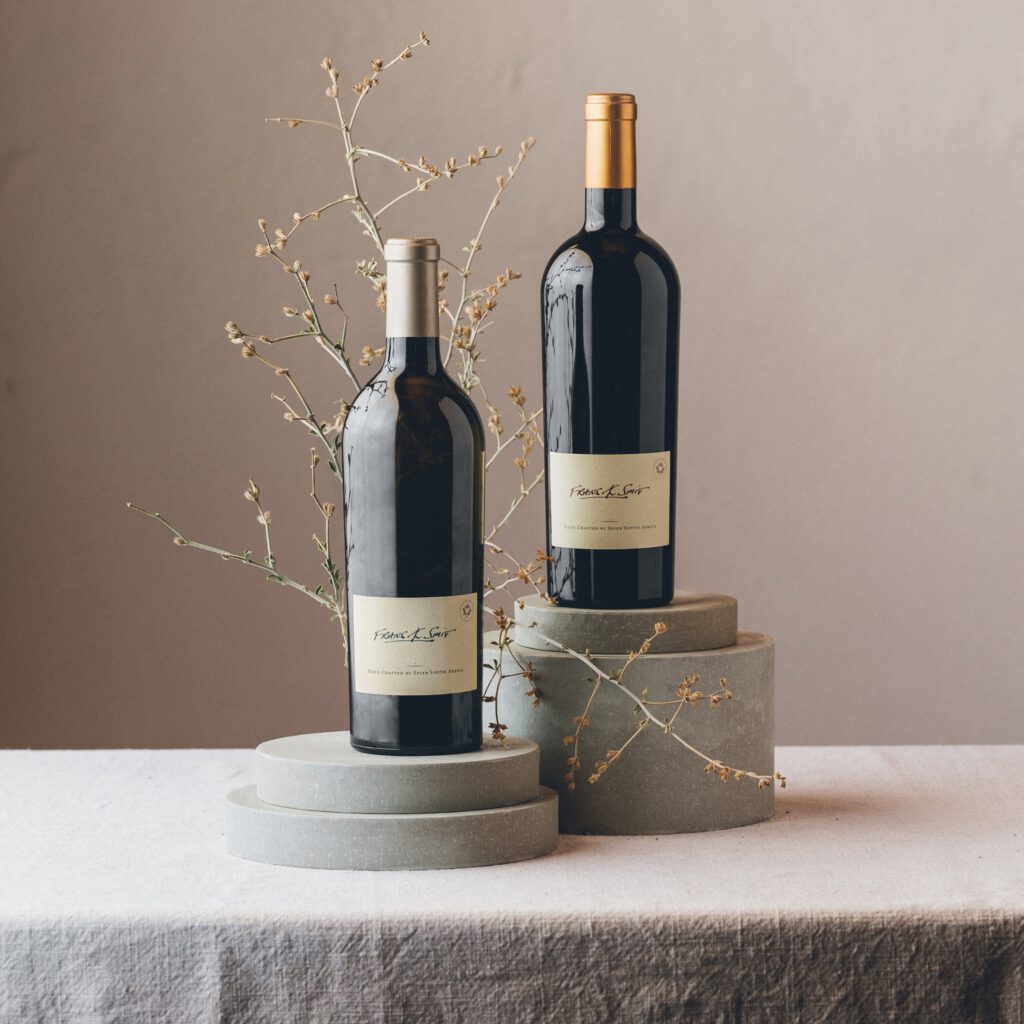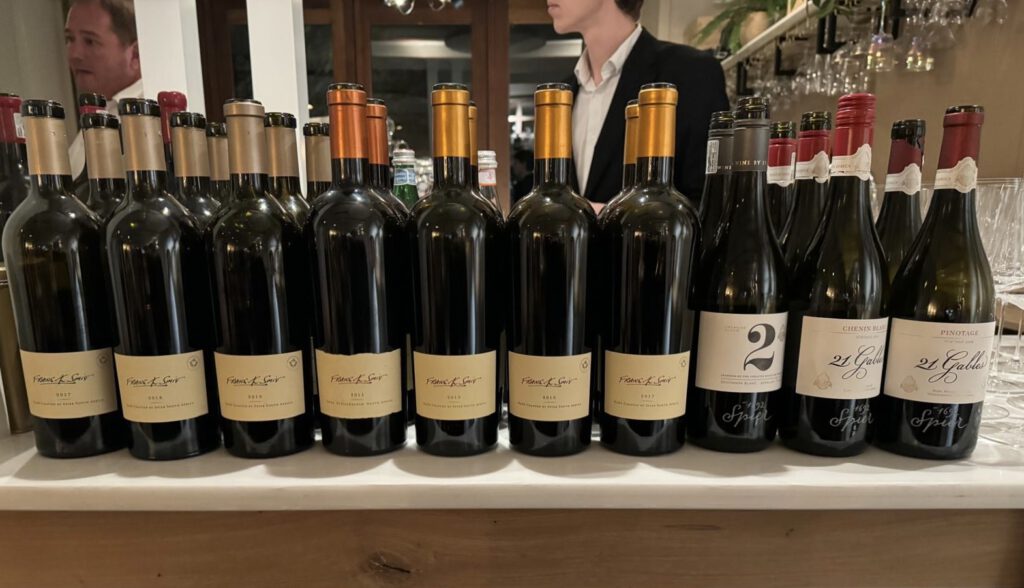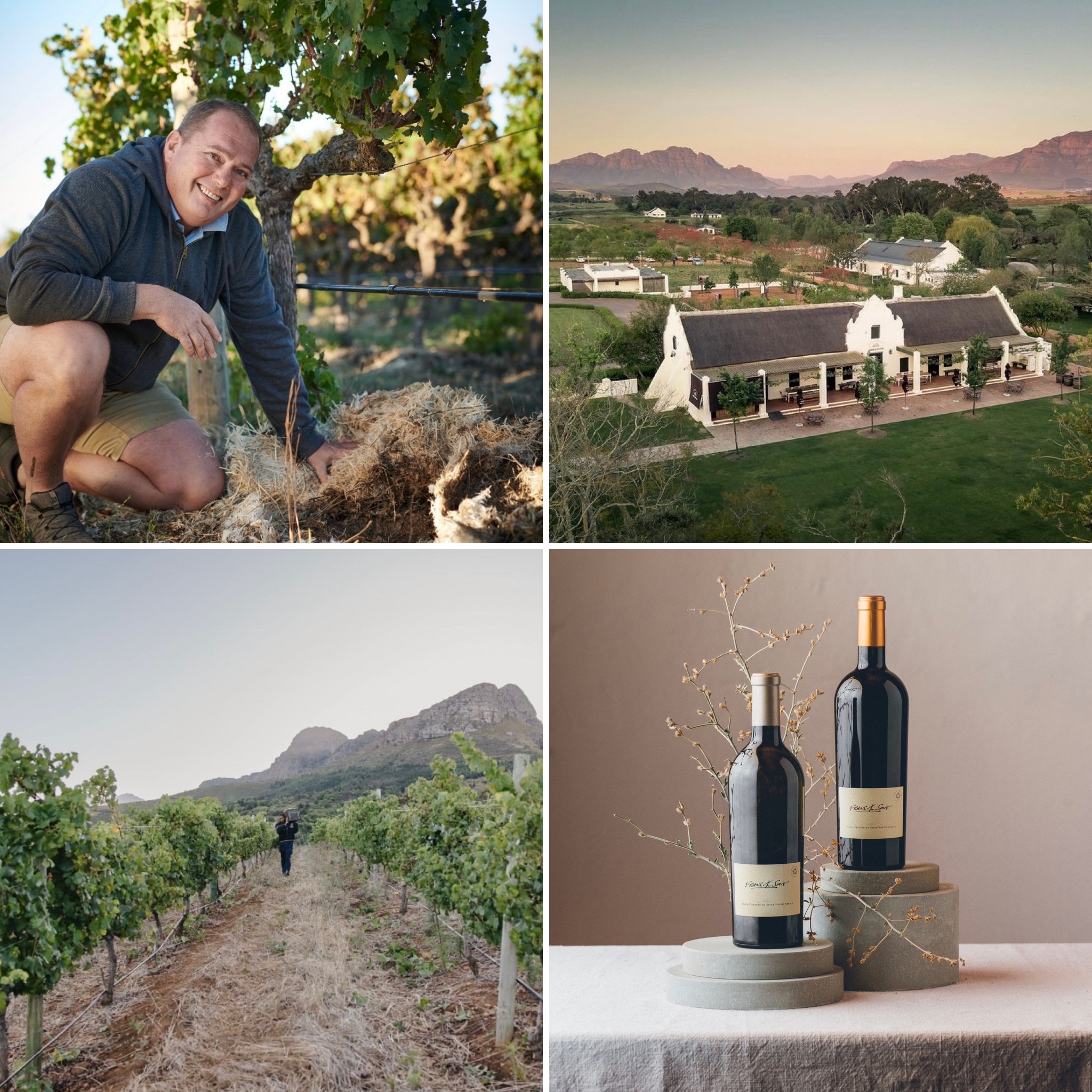Spier Wines, presenting the Frans K. Smit Blends.
‘A voyage inspired by classics, supported by knowledge, curiosity and blended with passion’
Upon invitation by Vinites we had the opportunity to enjoy a memorable evening with one of South Africa’s great winemakers, Frans K. Smit of Spier wines. During a pleasant and high-quality dinner at Restaurant Suzie’s & van Aken tasted Spier’s top range, consisting of white and red blends under the name ‘Frans K. Smit Blend’.
Frans K. Smit and Spier Wines
Frans, now the managing director of Spier Wines, guided us on a gastronomic tour at Restaurant Suzie’s & van Aken, following a South African wine route that led us to Stellenbosch. Spier Wines is situated roughly nine kilometers from the ocean, although not all of its vineyards are located on the estate.
Frans has been with the company since 1996. Upon his arrival, he quickly realized that “terroir is the most important thing if you want to craft really good wine.” Consequently, Spier began selecting and planting vineyards along the West Coast, extending as far as Darling. Today, Spier Wines owns vineyards all along the coastline, with a consistent oceanic influence that directly impacts the terroir.

The Frans K. Smit line – White Blends
The evening began with a vertical tasting of three white wines. Frans, who served as Spier’s cellar master for 27 formative years, shared his story as an introduction:
“When I was a young student studying winemaking, I was given two grape varieties. My first white grape was Sauvignon Blanc, and my red was Merlot. Later, I traveled frequently to Bordeaux, a region that greatly inspired me. In 2014, I decided to craft a white Sauvignon Blanc and Semillon blend similar to those found in Bordeaux. The aging potential of white Bordeaux wines, particularly those aged in oak barrels, fascinated me. Tasting 10- to 15-year-old wines that were still amazing brought me back to South Africa to create my own versions.”
In 2014, Frans attempted his first white Bordeaux blend, and it was fantastic. The first bottling occurred in 2015, during the midst of the most severe drought they had ever experienced. The 2014 vintage was wet, followed by an excellent 2015 vintage.
From 2015 to 2019, rainfall was less than 50% of the normal levels. By 2017, newspaper headlines read “No water in the Western Cape,” highlighting the drought’s severity and impact.
The three wines in our vertical tasting came from the same non-irrigated vineyards, with Semillon from south-facing Stellenbosch plots. Each vintage uses the same block of grapes.
Frans emphasized simplicity in the winemaking process: “Focus is on the quality of the grapes, not on technical winemaking.” Grapes are picked in 18kg boxes, cooled upon arrival at the winery, and then crushed. Depending on the vintage, the grapes undergo 8-9 hours of skin contact at 10 degrees Celsius to extract flavors. Some grapes are whole-bunch pressed for a soft, gentle structure. Fermentation occurs in 320L untoasted oak port barrels. Frans noted with a smile, “I don’t know, I tried it many years ago, and it works for me.”
There is no clear settling of the juice, resulting in high turbidity, which means no yeast nutrition is needed during fermentation as the yeast feeds on the lees material. After fermentation, the blend is completed in the winter (European summer, June/July). The wine then spends about 14 months in foudres. Frans prefers not to perform malolactic conversion, as the wine already has an abundance of flavors and a rich texture. For vintages like 2019 and 2020, Frans blends 5-10% of fresh wine into the mix just before bottling, depending on the vintage.

Our Tasting Notes
(2017-2018-2019)
2017
Driest vintage of the three presented.
Semillon exudes opulence on the nose with notes of caramelized hazelnuts and pear drop, complemented by sun-kissed hay and a hint of eucalyptus freshness. The palate reveals an oily texture balanced by high acidity, culminating in a long, vivid finish with herbaceous undertones. We reward this wine with a 96-point DWA score.
2018
Extremely small vintage for ‘Spier Wines’, ended up bottling only 2,500L of wine. Less Semillon than in 2017 as the grape offered elevated aromatic prominence.
The nose presents a super-concentrated tropical fruit basket of mango and papaya, with hints of marzipan and lemon curd. On the palate, high acidity is complemented by a touch of smokiness. The finish is long and thirst-quenching with a gentle phenolic grip. We reward this wine with a 95-point DWA score.
2019
The vintage brought significant rainfall just 40 days before picking, resulting in very high acidity. To balance this, the decision was made to pick riper fruit, leading to a wine with 14% ABV. Frans used more new oak due to the wine’s opulence. A unique feature of this vintage is the co-fermentation of grapes, a rare occurrence as it is uncommon to harvest two varieties simultaneously.
The olfactory senses are captivated by the typicity of Sauvignon Blanc, with aromas of fresh grass, boxwood, stinging nettle, and layers of tropical fruits like starfruit and guava. The palate is smooth and vibrant, well-balanced by high acidity, leading to a long, salivating finish. We reward this wine with a 93-point DWA score.

The Frans K. Smit line – The Red Blends
The second part of our journey took us to a vertical tasting of red wines from four unequal vintages: 2011, 2013, 2015, and 2017. Frans emphasized that he always structures tastings with either equal or unequal vintages. Unfortunately, the 2014 and 2016 vintages were lost in fires.
In the early days, Frans strongly believed Merlot would become South Africa’s most important grape variety. The first great vintage for Merlot was in 2004, marking the birth of the ‘Frans K Smit’ range. Another standout Merlot-driven vintage followed in 2012. Other vintages in the lineup are dominated by Cabernet Sauvignon. Up until 2014, Frans included a pinch of Syrah in the blend. However, as he matured as a winemaker, he adjusted his recipe.
Since the 2017 vintage, the final assemblage has consisted of Merlot, Cabernet Sauvignon, and Cabernet Franc. All grape varieties are destemmed, hand-sorted, and vinified separately in stainless steel tanks. Starting with the 2015 vintage, the winery began using an optic sorting machine to select grapes based on optimal ripeness.
Some batches are vinified in 600L barrels, where the barrels are rolled instead of using pigeage or remontage in stainless steel tanks. After 13-14 months, the first selection is made, and blending begins after 20 months. The total barrel aging time ranges from 22 to 30 months, but in recent years Frans has limited it to 24-26 months. After bottling, the wine remains at the estate for 2-3 years before reaching consumers.
Our Tasting Notes
(2011-2013-2015-2017)
2011
Very small and cool vintage.
Cabernet Sauvignon leads the blend, followed by Merlot, Cabernet Franc, and Petit Verdot. All grapes originate from Helderberg, separated from the ocean by a mountain range and facing northwest. Each day, a sea breeze arrives at 11 o’clock, contributing to a long ripening period.
On the nose, the blend reveals a mix of dusted red and black fruits, pencil shavings, sweet wood, and juicy black cherry, with hints of licorice and cloves. The palate is clay-dusted, featuring medium acidity and medium tannins. The finish is of medium length, with a powdered texture. We reward this wine with a 94-point DWA score.
2013
Even cooler than 2011.
The nose exudes refined elegance, featuring sweet cherry spiced with cloves and black plum sprinkled with cinnamon, complemented by a well-integrated oak profile. On the palate, high acidity is accompanied by medium, fine-grained tannins. The finish is long, with a lingering smoked plum flavor. We reward this wine with a 96-point DWA score.
2015
Exceptional vintage as around the world.
Frans bottled all three grape varieties separately as well. 800 bottles of each. At the winery, you are able to taste individual components of this exceptional vintage. An absolute optic approach.
The olfactory senses are drawn into a perfumed elegance of black fruit aromas, featuring black cherry and black plum dusted with powdered cacao. Notes of licorice, fresh coffee beans, roasted oak, and a hint of menthol add complexity. The palate is well-balanced, with high acidity and medium, fine-grained tannins. The finish is prolonged, offering a structured softness. We reward this wine with a 98-point DWA score.
2017
Great vintage in South Africa.
The nose presents a bright profile of blackberries and blueberries, complemented by a refined hint of perfumed roses. The palate is robust, with high acidity and medium, grippy tannins. The finish is of medium length, featuring a voluminous touch of smoked black fruit. We reward this wine with a 97-point DWA score.

A Journey Through Spier Wines’ Premier Craftsmanship
We traveled premium class to this top-tier winery in South Africa. Spier Wines, inspired by classics and driven by knowledge, curiosity, and passion, showcased their exceptional craftsmanship. The wines were perfectly paired with cuisine expertly prepared by the chef from Suzie’s & van Aken, Oegstgeest.
None of the three presented white wines exhibited any wood aromas, focusing instead on the pure expression of terroir, highlighting the winemaker’s sublime craftsmanship.
Our journey through the red wines satisfied our gastronomic thirst and provided insights into current developments in South Africa. Frans shared that precise attention is being paid to Cabernet Franc from higher altitudes, particularly as the vines age. “In the future, Cabernet Franc will play an even bigger role in Bordeaux blends of South African wines,” said Frans Smit.
To conclude we assemble the story with a quote of Frans: ‘Today I drink more Sauvignon blanc than anything else, if I can I drink more Merlot than anything else.’
This article is written by our own Jelena van Eerdenburg. Spier Wines is imported in the Netherlands by Vinites, and available through various retail and hospitality partners. We would like to thank Vinites, Spier Wines (Frans in particular) and Restaurant Suzie’s & van Aken for the great evening, wonderful dinner and excellent wines. Picture credits: Spier Wines, Vinites and Dutch Wine Apprentice.

